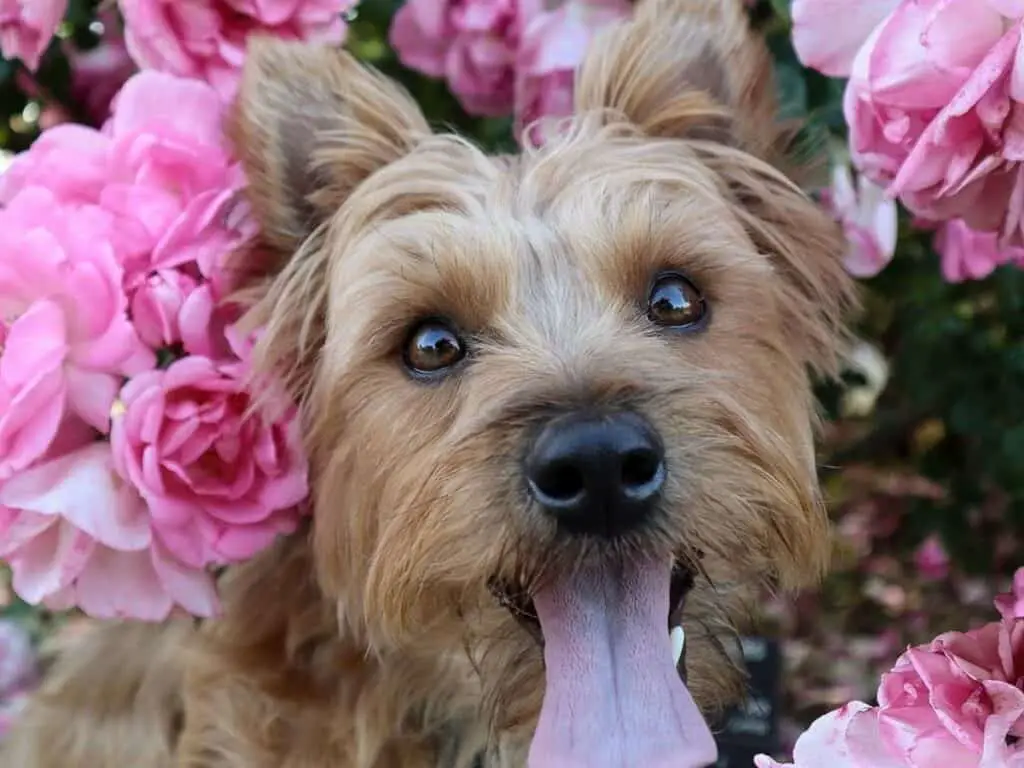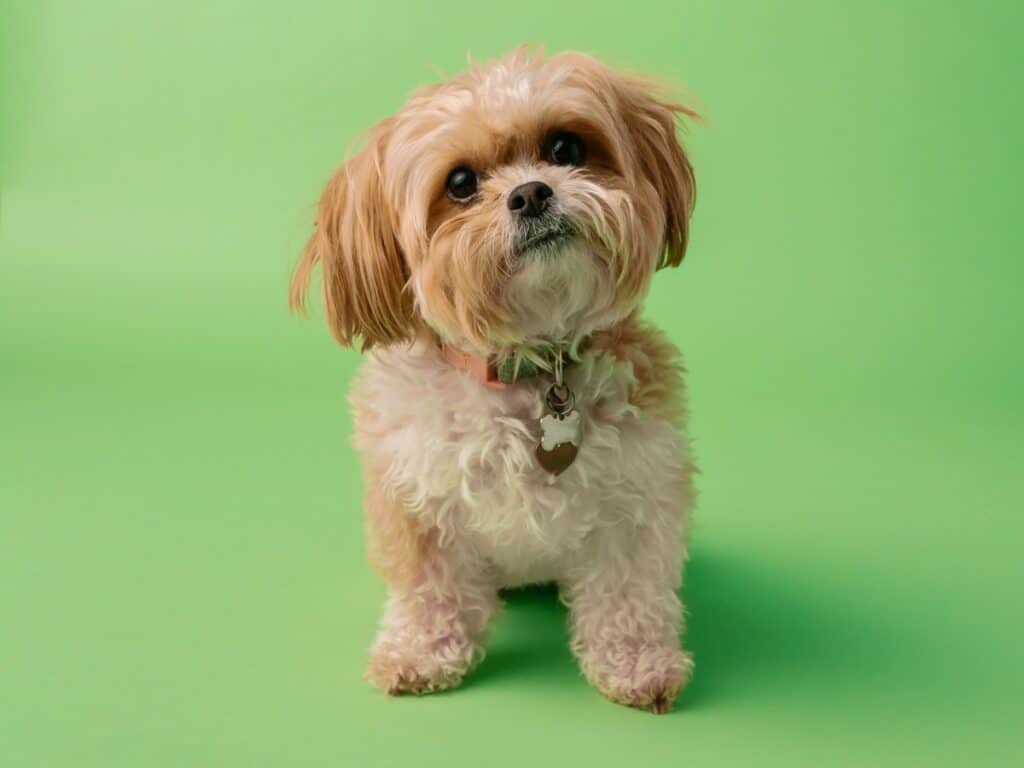Have you ever seen a Shorkie? We bet you were captivated!
And now you can’t stop thinking about this adorable pup. You ask yourself, “Is the Shorkie easy to care for? How much does it cost to own one? Could this be the perfect dog for me?”.
In this article, we’ll answer all three questions and many more. With the Shorkie’s elegant demeanor, beautiful coat, and winning personality, we can’t promise you won’t be enamored with these little friends.

Quick Facts: Shorkie
Height
6 - 11 inchesWeight
5 - 12 poundsLifespan
11 - 16 yearsBreed Size
small (0-25 lbs.)Breed Type
hybridBreed Group
companionTemperament
anxious, outgoing, playful, strong-willed, affectionateGood With
families, other dogs, catsIntelligence
highShedding
infrequentExercise Needs
moderateBarking Level
highEnergy level
highDrool Amount
lowCoat Type
straight, medium-to-longCoat Patterns
bi-color, brindle, tri-colorColors
black, fawn, red, white, blue, brownOther Characteristics
apartment-friendly, good for first-time pet owners, hypoallergenic, prone to health issues, requires lots of grooming, strong loyalty tendencies, tendency to chewShorkie Highlights
- They’re ideal for small households but can also thrive in larger family settings.
- They come in white, red, fawn, brown, black, blue main colors — there’s sure to be a color that suits your personality.
- Shorkies are compatible with allergy sufferers. They usually have straight, medium-to-long coats.
- Shorkie owners need to keep their pups’ nails and ears clean and maintain the coat regularly to keep them looking their best.
- These little dogs are so sweet and easy to care for, but they can be easily injured if played with too roughly.
- Although small, Shorkies won’t back down from bigger dogs, so make sure you’re always around to keep an eye on them.
Shorkie History
Shorkies are the new dog craze that originated in Great Britain. They’re a cross between the Shih Tzu and Yorkshire Terrier and are the epitome of adorable crossbreed.
Shih-Tzu

Their ancestry is a mystery, but it seems likely that the breed originated from the lion dogs in Tibet, living in incredibly lavished temples.
Lions are significant in the Buddhist religion, and that’s why many years ago, dogs were bred to resemble lions. These lion dogs were believed to be the house of the Buddhist monk spirits.
The responsibility of breeding and raising lion dogs in ancient China was given to the eunuchs of the imperial court. The emperor chooses the most attractive dogs and rewards the eunuchs with gifts. These chosen dogs were painted in tapestries and imperial dog books.
In addition to being lap dogs, the lion dogs served as guard dogs in the Buddhist temples. It was considered unlawful to sell these royal dogs, and anyone who tries to do so will receive the death penalty.
In 1750, lion dogs became an extinct breed in Tibet as war and civil upheaval dominated the Asian political picture. So, how did Shih-Tzu dogs come into the picture?
The empress of China, T’Zu His, received some Shih-Tzu dogs from the 13th Dalai Lama. She was a cruel empress, but she had a soft spot in her heart for these dogs and greatly influenced the rampant Shih-Tzu dog breeding in the country.
This breed was successfully imported several years later to other countries, including the United States. It is recognized by the American Kennel Club and takes the 20th spot for the most popular dog breeds in 2020.
Yorkshire Terrier

They originate from the region of England, Yorkshire, which they are named after.
Yorkshire Terriers (Yorkies) were bred to become rat catchers! Thanks to their small size and agility, these dogs are perfect for catching rats in Yorkshire mills and mines during the 19th century.
Which dogs are the ancestors of the Yorkshire Terrier? Based on the breed’s appearance, it is thought that Yorkies are a mix of many different breeds — Skye, Paisley, and ClydesdaleTerriers contributed to their creation.
Did you know that Yorkies were considered one of the most popular dog breeds of the Victorian era? Yorkshires’ long luscious coats not only distinguished them from other toy dogs but owning one became a symbol of luxury and prestige for the upper classes.
In the late 1860s, an incredibly popular show dog named Huddersfield Ben defined the characteristics of the Yorkshire Terrier breed type. This legendary dog quickly became a household name in dog shows and competitions.
By the 1870s, Yorkshire Terriers had become an official breed and were being raised all over the world! They were highly popular in England and America, with everyone loving their friendly personalities and small size.
By the 1870s, the breed had been given its official name, Yorkshire Terrier, and had made its way across the Atlantic, proving as popular in America as in England, thanks to its small size and friendly nature.
Appearance
Being a combination of two different breeds, the appearance of Shorkies can be completely unpredictable, but we’ll give you a rough idea of what to expect. They can have the same round face as the Yorkshire Terrier and may very well inherit the cute little Shih Tzu’s Brachycephalic face.
Shorkies normally have thin legs; though they are small, their muscle is proportional to their body size. Their thin tails will be wiggling and curling in all directions, and in excitement, the tails may even stand straight up.
Shorkie Size
Because their parents are both small dogs, you can expect the Shorkies to be on the smaller side. They are usually no taller than 11 inches and weigh between 5 and 12 pounds.
Shorkie Colors
Shorkies come in any combination of white, red, fawn, brown, black, and blue. The color of their face is often darker than their bodies.
Coat
The Shorkie’s silky coat will be straight and medium in length with a soft undercoat. This coat is excellent for people who suffer from allergies.
Personality


If there’s one thing Shorkies love, it’s getting their little yet bouncy selves moving and having some fun. Their favorite activities include playing hide-and-seek and chewing on chewing squeaky toys. They’re especially fond of interactive toys and puzzles — their smart little brains are always working.
This dog is great for keeping the kids busy in an apartment. He loves playing fetch with them and racing to get the ball. Combined with regular short walks around the neighborhood, they’ll definitely be releasing all the extra energy.
Bonus point for Shorkies: If you’re thinking of taking your Shorkie for a walk in the park or to the playground, make sure you’re mindful of their small size as they can move quickly. Do not bring Shorkies outdoors without a securely fit leash as these dogs can be incredibly fast.
Shorkies are the ultimate sidekick. They’ll be happy to tag along on your errands. They’re the perfect little companions and will make everyone smile.
But they can also be a little too clingy at times. Shorkies are known for being incredibly attached to their people, and can become quite distressed when separated from them for extended periods. Like most dogs, they can be prone to experiencing separation anxiety.
As well as having strong attachment tendencies, Shorkies are willful and difficult to house train. But with early training, you can control any unwanted habits.
In addition, Shorkies are great barkers. They love to announce visitors and let you know when mail is coming. So don’t be surprised when you hear them barking whenever someone comes by, or the postman arrives.
Health
Some of the same problems that the Shih Tzu and Yorkshire Terrier are predisposed to, such as stress, anxiety, glaucoma, and hypoglycemia, can be seen in Shorkies. Learn how to spot the signs of these health problems in Shorkies and how to treat them.
Stress
Shorkies often go into hiding to feel safe when they are stressed. Other indications of a stressed Shorkie include avoidance or displacement behavior, panting, yawning, drooling, licking, whining, barking, pacing, and shaking. If you’re familiar with your Shorkie’s normal mood and behavior, you can easily tell if he is stressed.
No one knows better than you how your dog is feeling, so find the source of their stress and make some changes to alleviate it. Maybe moving your puppy away from a stressful environment will resolve the problem.
Shorkies respond best to routine commands like sit, wait, stay, and lie down. These commands help keep your dog distracted and feel like everything is normal.
If you notice that your Shorkie is acting out of character, be sure to see your veterinarian for a check-up. If your vet determines that your furry friend is experiencing stress due to issues in their environment or with other animals in the home, your vet may refer you to a canine behaviorist who can help manage your Shorkie’s stress levels.
As with humans, a game of fetch or a walk to the park with your dog is a great way to reduce stress — for both of you.
Anxiety
There are so many ways that Shorkies can become anxious or nervous. Some of the most common reasons include being around new people, new animals, loud noises, and intense changes.
Social anxiety in dogs can sometimes lead them to exhibit disturbing behaviors like barking furiously and preying on the new pet or person.
Getting your dog to overcome their anxiety can be a challenge, but it is definitely possible with the right approach. The first step is determining what is causing their anxiety in the first place.
Next, taking your dog to the vet is a great way to determine why he is feeling stressed and learn what steps you can take to help him feel better.
Besides social anxiety, your dog can also suffer from separation anxiety. A dog’s natural instinct is to be with its family, but sometimes they get anxious when left alone. Boredom or loneliness (which can add up over time if not addressed) causes separation anxiety in dogs. This is a common scenario for owners who work long hours and go on long trips. The dog, when anxious, may chew the furniture, bark loudly, whine or howl excessively.
How do you manage separation anxiety in Shorkies?
Don’t be emotional or over excited when you leave for work or when you return home. This way, your dog will know that the time apart is normal, and he will eventually get used to seeing you leave and return.
Another way to ease your pup’s anxiety is to get them a separate dog bed. Not only will this make them more independent, but also sleep better on their own. Of course, if you exercise and tire out your dog, he will be much less likely to become anxious or destructive when left alone, but rather divert her attention to sleep.
Finally, your Shorkie can learn to be alone for part of the day but not for days on end. If you’re like most busy dog owners, errands fill your days. Structure these errands, so you’re only away for a few hours. If you need to leave for several days, don’t worry! Many options are available to ensure your pet is taken care of. You could ask a friend, relative, or doggy daycare service.
Glaucoma
Did you know that one of the causes of Glaucoma in dogs is usually high pressure inside their eye? If left untreated, this condition can damage the optic nerve, resulting in blindness.
You can easily recognize acute glaucoma in dogs by sudden eye changes and behavior. These include increased watery discharge from the eye, redness in the whites of the eyes, bulging of the eye, avoiding being touched near the affected eye, rubbing the eye, not eating, and acting quieter than usual.
Moreover, dogs with chronic glaucoma can experience slight eye enlargement, slightly distended eye veins in the white of the eye, slightly dilated pupils that are slow to respond to light, and a cloudy outer layer of the eye.
And what’s worse? If your dog has glaucoma in one eye, she is at significant risk of developing glaucoma in the other eye if not immediately treated. Veterinarians consider this eye disease as a medical emergency, and they usually treat it with antibiotic injections, drainage implants, laser treatment, and surgery.
Hypoglycemia
If Hyperglycemia means high blood sugar, Hypoglycemia is the complete opposite. Hypoglycemia occurs when a dog’s blood sugar levels fall too low. Shorkies are not only prone to low blood sugar, but they can also die from it if treated late.
If your dog has low blood sugar, he may experience impaired vision, impaired coordination, collapsing, refusing to exercise, fainting, drowsiness, seizures, and altered behavior.
If you think your dog’s blood sugar is low, don’t wait. Bring your dog to the clinic as soon as possible so that the vet can adjust his blood glucose levels.
Lifespan
The Shorkies are known for being one of the longest-living breeds in the world, and their lifespan shows why. They typically live between 11 and 16 years, which is incredibly impressive.
Read also: The Shih Tzu Lifespan: How Long Do Shih Tzus Life For?
Care
The Shorkie is an active dog that needs plenty of exercises to keep them healthy and happy. A good rule of thumb is to aim for around 30 minutes of walking each day, so make sure you’re up for it. If there’s a fenced backyard or local dog park close by, that’s even better. The Shorkie will have lots of fun running around, chasing balls or toys, and spending time with other dogs.
Even if Shorkies are not cut out for lounging around the house all day, they can easily adjust to your own lifestyle and routine. There’s no need to have an enormous backyard or be an avid outdoors person to be an ideal owner for a Shorkie. If you live in an apartment, Shorkie dogs will still love having that extra activity indoors, whether it’s fetching a ball or trying to drag each other around in a tug-of-war.
Diet
Look for high-quality food that is suitable for energetic small breeds. You’ll be able to find a pet food retailer near you that will have the perfect food for your energetic little friend.
But overfeeding your Shorkie can cause them to put on weight. That’s why it’s so important to feed them smaller meals on a regular schedule to keep their energy levels up.
As your Shorkie’s dietary needs change throughout their lifetime, be sure to ask your veterinarian for continued advice on what foods are the most beneficial for them.
Grooming
If you have a Shorkie, you know their coat always needs attention. You should definitely keep up with regular brushing and visits to the groomer. Your Shorkie will look great and stay healthy this way.
While these dogs look super adorable in a “teddy bear” cut, getting your Shorkie used to regular handling and grooming from a young age is key to achieving this look. Your regular visits to the groomer should be a fun experience for your dog, and not something that causes her stress.
Don’t forget to keep your Shorkie’s nails trimmed and her ears clean.
Shorkie Puppies

Some Shorkie puppies might look more like one parent than the other, or they could come out with some mixed characteristics of both parents. The litters are usually fairly small — no more than five pups!
Even though you’ll probably want to cuddle them all day long, these little guys will need early socialization and puppy kindergarten classes to learn how to behave. With the right training, your Shokie will reach his full potential as a friendly and well-mannered dog. This could help prevent any behavioral issues from developing in the future.
These puppies are the perfect little addition to any family. They’re small and super cute. Be careful with them, though — they can be easily knocked over. Hence, don’t leave your children unsupervised with a Shorkie puppy.
Children and Other Pets

Sleeping in the crate overnight is a great way to speed up house-training in most puppies. With enough socialization training, Shorkie puppies can learn to get along with others quickly. If you give your Shorkie the opportunity to meet other friendly dogs and allow them to interact with relatives and friends, they will eventually become more outgoing and friendly.
Rescue Groups
These dogs began as a designer breed, but some of them ended up in shelters and rescue groups. Adopting is the way to go if you’re considering getting a Shorkie.
Check out these Yorkshire Terrier and Shih Tzu rescue groups, which also take in mixed breeds like Shorkies.
Yorkie Rescue of America – Los Angeles, CA
Yorkie Rescue Houston (YRH) – Texas
NC Yorkie Rescue (NCYR) – North Carolina
Yorkshire Terrier National Rescue (YTNR) – Tennessee
Shih Tzus & Furbabies Rescue – Georgia
Shih Tzu Rescue of Minnesota (STRMN) – Minnesota
Shih Tzu Rescue, Adoption and Education Safehouse (STRAES) – Illinois
New Beginnings Shih Tzu Rescue, Inc. – Wisconsin
Bluegrass Shih-Tzu Rescue – Kentucky
Save a Shelter Shih Tzu (SASS) Rescue – Ohio
Shih Tzu Rescue, Inc. – Florida
Shorkie FAQS
How big is a Shorkie?
They are considered small dogs and usually stand between 6 and 11 inches tall and weigh between 5 and 12 pounds.
How much is a Shorkie worth?
You can expect to spend $500 to $1,000 for every Shorkie puppy. However, numerous Shorkie owners agree that they are completely worth their high price tags considering how fun and playful these little pups are.
How long can a Shorkie be left alone?
If you have a Shorkie, you need to be extra careful with how long you leave them alone. Four hours is the maximum time, and they need access to water while you’re gone.
Are Shorkies hard to potty train?
No. Potty training a Shorkie is so quick and easy. With just a little bit of consistency, positive reinforcement, and some delicious treats, your pup will be able to go potty on cue in no time.
Do Shorkies like to cuddle?
Yes. They love to cuddle and want nothing more than to be physically close to their owners. So if your Shorkie dozes off while sitting or lying next to you, continue to give it peace and comfort by staying still.
If your Shorkie falls asleep in your arms, it means that she really loves being held and cuddled. Don’t worry about those tight hugs if you don’t like them — Shorkies love light, soft hugs too!
Shorkie Fun Facts
- The Shorkie is just the cutest dog ever, and you can call him whatever you want — Shih Tzu Yorkie Mix, Yorkie Tzu, or Shorkie Tzu.
- This designer breed is recognized by The American Canine Hybrid Club.
- There are no set standards for Shorkie puppies, meaning each is a unique mix of personality and looks.
References
Cook, C. S. (1997). Surgery for glaucoma. Veterinary Clinics of North America: Small Animal Practice, 27(5), 1109-1129.
Sherman, B. L. (2008). Separation anxiety in dogs. Compendium, 30(1), 27-42.




